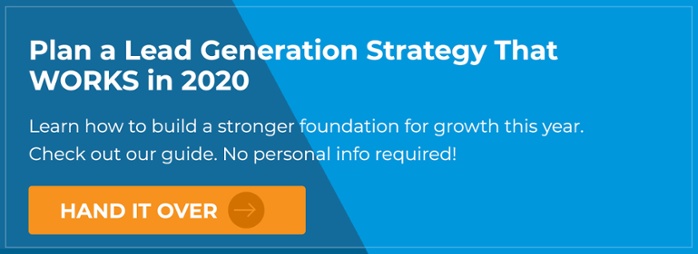
5 Ways to Boost Your Lead Nurturing Strategy
Patrick Dodge
Founder
Your brand might be spending a lot of time and money generating leads. But, how are you building relationships with them?
A lead nurturing strategy can help you strengthen those relationships and keep your sales team from wasting time on bad-fit prospects.
We’ve run dozens of nurturing workflows for our clients in HubSpot, and in that time we’ve uncovered best practices that have help us convert sales qualified leads at a rate of 50 percent or more.
We’ll explain five key ways you can boost the results of your own lead nurturing campaigns, but first let's cover a few fundamentals.
What is Lead Nurturing?
Lead nurturing is the process of guiding a prospect through the buyer’s journey, while also qualifying them as a good match for your products or services.
In an inbound marketing strategy, lead nurturing involves engaging a potential buyer with a series of helpful messages that educate, entertain, and entice them to want to learn more about your solution.
Throughout the process, your team can use marketing analytics and lead scoring to monitor the prospect’s response, while gaining insights about their challenges and readiness to invest in a solution.
What is the Difference Between Lead Nurturing and Lead Generation?
Lead nurturing and lead generation are both important for acquiring customers, but they differ in important ways.
Lead generation is about attracting visitors to your website or online presence and encouraging them to take a specific action -- a conversion -- that enables your company to continue marketing to them. Lead nurturing, by contrast, is every step your team takes to help new leads with the goal of converting them into customers.
Lead Nurturing Stages
Each engagement with a potential buyer should follow a pattern designed to help them at each phase of the decision-making process. This can be broken down by three stages:

- When people realize they have a particular challenge, they search for information about how to solve it (Awareness).
- Then, they start comparing different solutions, weighing the pros and cons of each (Consideration).
- Finally, they narrow the choice to a couple options that offer the greatest value, and either select one themselves or contact Sales for more information (Decision).
Notice how your company’s sales team isn’t even a part of the conversation until the very end?
This is why lead nurturing is so important, especially with high-consideration, B2B purchases. Buyers do not need salespeople to research their options -- we have the internet for that.
Our job, as marketers and salespeople, is to provide them the resources to make an educated decision.
As they move from one stage of the decision-making process to the next, buyers have different informational needs. A good lead nurturing strategy will anticipate those needs, and help them with quality, objective content.
Key Elements of a Lead Nurturing Strategy
Understand Your Buyer Personas
Before launching your campaign, you need a thorough understanding of how your buyers make decisions.

The best way to do this is through unscripted interviews with people who have recently evaluated and purchased a solution like yours, but make sure they are not familiar with your brand. You will get honest, unfiltered feedback from buyers who have no previous relationship with your brand.
Lead Generation Strategy
You should already have a proven strategy in place for converting visitors into leads on your website. You should only attempt to nurture leads that have explicitly opted-in for marketing communications from your brand.
Marketing Automation and Analytics
Marketing platforms like HubSpot will allow you to automate email sequences, set conversion goals, and measure how your buyers respond. These insights will not only help you optimize your messaging, they will also help you trace ROI to your lead nurturing campaign.
Helpful Content
Lead nurturing is effective when brands truly understand how buyers do their research and respond with messaging that helps them make a decision. Driving them to blog posts, videos, long form guides, and other content that answers their questions is the best way to get them to engage.
Email Marketing and Social Media
Emails and targeted social media posts are two important drivers of lead nurturing campaigns. With each touch-point with a potential buyer, you should offer them content that helps them learn while you gain insights about them.
"As they move from one stage of the decision-making process to the next, buyers have different informational needs. A good lead nurturing strategy will anticipate those needs, and help them with quality, objective content."
How to Boost Your Lead Nurturing Strategy
1. Advance the Sale By Moving From Basic to Advanced Content.
Each communication with your buyers should be designed to help them learn and move one step closer to a purchase.
At the Awareness stage, people are new to a specific challenge and need to learn more about it.
For example, naturopathic physicians have patients that experience hormonal imbalances due to unmanaged stress, so they might search for information about “high cortisol problems.”
After finding and downloading this guide where they learn about how stress affects various metabolic pathways, doctors are enrolled in a lead nurturing campaign that uses email and social media to educate them about addressing these health issues.
As they progress through the campaign, they learn how specific nutrients help regulate cortisol in the body. This exploration eventually leads to how specific branded ingredients deliver a more powerful dose to people.
The nurturing campaign guides their learning from a broad based exploration of a challenge to the granular details of a solution, while the brand monitors engagement and qualifies each prospect as a good-fit for the business. This is how a high performing lead nurturing campaign works!
2. Use Ungated Content to Increase Engagement.
A lead nurturing campaign usually kicks off when a visitor takes a conversion action on your website, like filling out a form for a downloadable resource or starting a chat.
After that conversion, the visitor has become a lead that’s ready for qualifying in a nurturing campaign. Throughout the process, you may want to send the lead other downloadable offers that will help you to gather insights about their needs and readiness to invest in your solution.
If you do, make sure most of the content you send them is “ungated,” or accessable without filling out more forms.
Form fatigue is a real problem today as brands try force people to give up personal information too often to access anything of value on their websites.
You will have much better results by exercising restraint when it comes to gated content and making your lead nurturing campaign easy and frictionless for the user.
3. Implement Lead Scoring.
Lead scoring is assigning numeric values to leads in your pipeline, based on qualifying attributes and user behavior.
This is an efficient way to gauge where the prospect is in the buyer’s journey, and whether they might be a good fit. These values can be based on qualifying attributes like demographics, company size, annual revenue, and other properties you’ve gathered about them.
You can also based them on actions they’ve taken on your website and elsewhere on the internet:
- Forms filled
- Pages visited (including pricing information)
- Emails opened and clicked
- Calls-to-action button clicks
- Social engagement
Lead scoring is valuable for monitoring the effectiveness of your nurturing campaign…as long as you keep it simple.
It’s easy to overcomplicate things by adding too many too many scoring tiers and actions for monitoring.
Focus on the actions and behaviors that matter most, according to data you’ve gathered about your current customers. You should also try using value ranges that are small and easy to understand. If a lead has opened one or two emails, you might assign one “point.” If they’ve opened five or more, a high score of five might be all you need to quantify this engagement.
Make sure the values you assign reflect the importance of the action. Opening an email or clicking a social media link are relatively minor interactions. Filling out multiple forms, on the other hand, is behavior that should rank high on your lead scoring.
4. Segment Your Lists.
Marketing is most effective when the message is customized to smaller groups of people that share important values, goals, and attributes.
You can customize your lead nurturing campaign by collecting the most important shared characteristics about the lead and using it to trigger the nurturing workflow.
Let’s say your company sells interior decorating services to senior living communities, and you have a guide for creating an optimal floor plan that gets several downloads every month.
By asking the visitor whether they work for a senior living facility in the form, you can identify a potential lead and enroll that person in an appropriate workflow designed to help people in that industry plan their interior layout better.
The trigger criteria for your nurturing campaign should be specific enough to tailor your communications in an impactful way, but also inclusive enough to make sure you aren’t choking off the supply of leads you can help!
5. Sales Outreach is a Must.
No matter how great your content is, no matter how great your solution is -- some leads will not buy your solution. That's a reality all marketers face.
Some of them might find a competitor is a better fit, while others may not be ready to make any investment at all. For every lead you successfully nurture into a customer, there will be many others who don’t cross the finish line.
We have a suggestion for people who fall into the latter category:
Segment them into “interested” or “not interested” lists. At some point in your nurturing campaign you likely sent them an email or a social media ad about your solution to their challenges.
Did they click and view the website page(s) with details about your offering?
If they did, and their lead score is high, they may be ripe for a phone call or a 1:1 email from someone on the sales team.
A lead that has demonstrated clear interest but hasn’t converted into a customer may have unanswered questions that can be quickly cleared up with a simple phone call.
Relying too heavily on marketing automation will cause you to miss valuable opportunities if you’re not careful. Automation is great, but remember – people buy from people.
Lead nurturing can be simple or complex, depending on your sales cycle and how your buyers make decisions, but I would encourage you to keep them short and focused on specific goals. Monitor engagement with each component and make tweaks that help you improve the outcome.
When you’ve got a qualified, and well-informed prospect who wants to talk about your solution at the end of the campaign, you should have great insights in the CRM about that person’s needs and interests that result in a fantastic exploratory call. Your ace sales team can take it from there!
Dec 8, 2020 10:05:52 AM


